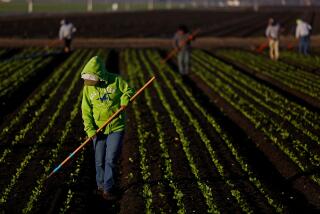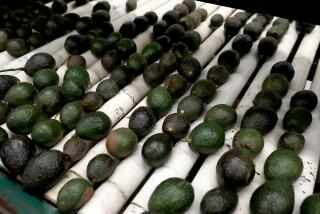Agribusiness Hits Back
- Share via
An agribusiness coalition has launched a costly promotional campaign to restore confidence in the nation’s food supply. The Washington-based Agriculture Council of America is coordinating the effort--FoodWatch--and has collected $750,000 in donations during the past 11 months from various commodity groups, chemical manufacturers and individuals.
The program is the latest in a series of steps being taken by agriculture interests to counter criticism over pesticide usage and other food safety issues.
Last week, for instance, Washington State apple growers filed a $150 million lawsuit against CBS-TV and the Natural Resources Defense Council because of losses stemming from the 1989 Alar controversy. Another recent indicator of the farm sector’s public relations offensive was its well-financed campaign to defeat California Ballot Proposition 128 or “Big Green.”
“Absolutely, there is a new aggressiveness,” said Ellen Haas, executive director of Public Voice for Food and Health Policy in Washington. “There have been signs over the last six months that the food and agribusiness industries are going to invest heavily in this kind of advertising.”
Haas claims, however, that FoodWatch’s goal is to “distort” food safety issues. “This is an effort to pull the wool over consumers’ eyes and to anesthetize the public into thinking no problem exists in the food supply,” she said.
FoodWatch’s current centerpiece is a television commercial portraying Pennsylvania Dutch town folk gathering for a meal in a church yard next to a corn field. The background music is a rendition of “Amazing Grace.”
The only words spoken during the spot are at its conclusion when a narrator says, “America’s bounty: Brought to you by the 20 million men and women who put food on your table.”
The commercial’s debut was on Thanksgiving Day in as many as 120 television markets. All the air time was purchased by supportive corporations or donated by local stations as public service announcements, a device that yielded significant savings for the FoodWatch campaign.
Future components of the program include media relations, newspaper/magazine advertisements, public opinion polling and distribution of educational materials.
“FoodWatch is designed to build public confidence in the food and agriculture industries and in the institutions that guide them, both public and private,” said Judy O’Hara, executive director of the Agriculture Council of America.
The FoodWatch solicitations are not as bucolic as the program’s generic television commercial. A recent advertisement in California Farmer magazine was headlined, “What Would You Give to Tell Your Side of the Story?” The ad talks about a “nationwide crisis of confidence,” “confused consumers” and “making sure we’ll be able to control our future.”
O’Hara said that major contributions and support from more than two dozen chemical companies and affiliated trade groups have not hurt FoodWatch’s credibility.
“The (chemical interests’) participation represents the fact that some segments of industry feel that this problem is more important than the others do,” she said. “No segment of agriculture should be excluded (from FoodWatch) nor have an undue amount of influence.”
She also points out that 30% of the funds raised to date are contributions of $500 or less from individuals or local organizations such as the Boone County, Ind., Farm Bureau.
The major presence of chemical companies and trade groups does bother Public Voice’s Haas.
“It hurts their credibility and demonstrates the viewpoint that they are taking: Defend the status quo and chemicals in agriculture,” Haas said.
A spokesman for the National Agriculture Chemical Assn. said that his group--by supporting FoodWatch--is just trying to explain farming to a vastly urban American public.
“This is an excellent program that is supported by all of agriculture, and we are a part of agriculture,” said Christopher Klose, vice president of the Washington-based chemical association. “It is our business to help farmers produce safe, abundant and nutritious supplies of food, and Americans do that better than anyone else in the world.”
FoodWatch’s O’Hara says she knows of no formal criticism of the program from activist groups. In any event, both consumer advocates and environmentalists will be added to the program’s advisory committee, which will be announced next month, she said.
“An important part of the advisory board will be from consumer and environmental organizations. Otherwise (the program) is not valid,” she said.
Rod Leonard, executive director of the Community Nutrition Institute in Washington, remains skeptical about the motives behind FoodWatch.
“I wish the industry would instead spend all this money to clean up the problems with contaminated foods, promote safety in poultry processing and reduce the use of chemicals in agriculture,” he said.
More to Read
Inside the business of entertainment
The Wide Shot brings you news, analysis and insights on everything from streaming wars to production — and what it all means for the future.
You may occasionally receive promotional content from the Los Angeles Times.










